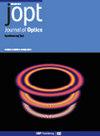Tackling the focal shift effect for metalenses
IF 2.7
4区 物理与天体物理
Q3 OPTICS
引用次数: 0
Abstract
We present a theoretical analysis aimed at comprehending and mitigating the focal shift phenomenon in planar dielectric metalenses. To conduct this analysis, we introduce metalens designs consisting of silicon and germanium nanoblocks on a calcium fluoride substrate, operating in the mid-IR frequency range. The lensing performance of these metalenses is investigated using the finite-difference time-domain method, and they operate at wavelengths of 3 and 4解决金属透镜的焦移效应
我们提出了一项理论分析,旨在理解和缓解平面电介质金属透镜中的焦距偏移现象。为了进行这一分析,我们介绍了由氟化钙基底上的硅和锗纳米块组成的金属透镜设计,工作在中红外频率范围。我们使用有限差分时域法研究了这些金属透镜的透镜性能,它们在波长为 3 和 4 µm 的波段工作,偏振转换效率接近于 1。我们的研究结果表明,介电金属透镜上的焦移现象与数值孔径(NA)之间存在很强的相关性,揭示了增加菲涅尔数并不总是最小化焦移的有效方法。与以往的研究不同,我们定义了一个与透镜尺寸无关的临界 NA 值,在该值下,焦距偏移达到最小值,从而形成对称的焦距强度分布,最终产生性能更好的金属透镜。我们证明,当 NA 大于确定的临界值时,平面金属透镜上会出现正焦距偏移,这与现有模型预测的传统负偏移不同。此外,我们还证明,通过在特定 NA 范围内选择直径较小的金属透镜,可以实现较高的聚焦效率。据测量,所研究的金属透镜的聚焦效率高达 70%,是迄今为止在红外范围内报告的最佳值之一。这些结果为提高实验和设计金属透镜特征之间的一致性提供了指导,从而增强了它们的实际应用。
本文章由计算机程序翻译,如有差异,请以英文原文为准。
求助全文
约1分钟内获得全文
求助全文
来源期刊

Journal of Optics
OPTICS-
CiteScore
4.50
自引率
4.80%
发文量
237
审稿时长
1.9 months
期刊介绍:
Journal of Optics publishes new experimental and theoretical research across all areas of pure and applied optics, both modern and classical. Research areas are categorised as:
Nanophotonics and plasmonics
Metamaterials and structured photonic materials
Quantum photonics
Biophotonics
Light-matter interactions
Nonlinear and ultrafast optics
Propagation, diffraction and scattering
Optical communication
Integrated optics
Photovoltaics and energy harvesting
We discourage incremental advances, purely numerical simulations without any validation, or research without a strong optics advance, e.g. computer algorithms applied to optical and imaging processes, equipment designs or material fabrication.
 求助内容:
求助内容: 应助结果提醒方式:
应助结果提醒方式:


